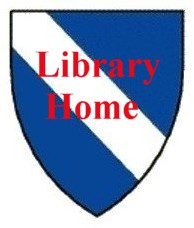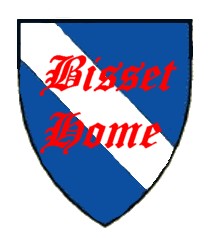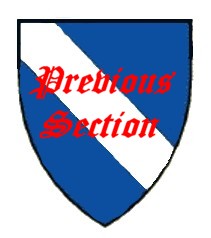
Chapter 1:
Introduction

 |
Chapter 1:
|

|
The situation today is that the greater family of Bisset is scattered outside Scotland world wide and found predominantly in the old English speaking Dominions and the United States. The Bissets taking a keen interest in their genealogy and history.
Bisset is of course found in the UK and I have used a breakdown from the 1881 census, although now nearly a 130 years old, of the distribution of the names BISSET and BISSETT found in England, Wales and Scotland. There is nothing significant about the year 1881 other than it can be seen as post Industrial Revolution, post the first great wave of emigration from the UK and prior to the many upheavals of the 20th. C, so in that respect it can be seen as a good general benchmark to name distribution.
BISSET: there were 2349 persons recorded with this name of which the distribution in the top ten counties was:-
| Rank | County | Numbers | Rank | County | Numbers | |
|---|---|---|---|---|---|---|
| 1 | Aberdeenshire | 569 | 6 | Perthshire | 191 | |
| 2 | Fife | 294 | 7 | Ross & Cromarty | 89 | |
| 3 | Midlothian | 260 | 8 | Kincardineshire | 75 | |
| 4 | Angus | 210 | 9 | West Lothian | 47 | |
| 5 | Lanarkshire | 200 | 10 | East Lothian | 41 |
The most interesting fact is the almost total disappearance of the name in England, Middlesex 36 people, Devon 17. The medieval historic Bisset locations such as Nottinghamshire and Lincolnshire show nil returns with Wiltshire and Hampshire showing 3 and 1 respectively. So we can reasonably conclude that not only did the main lines fail in England but also the name as a whole seems to have failed to survive in any significant numbers.
BISSETT: there were 708 persons listed bearing that name in 1881 in England Wales and Scotland, and the main distribution was:-
| Rank | County | Numbers | Rank | County | Numbers | |
|---|---|---|---|---|---|---|
| 1 | Lanarkshire | 106 | 6 | Surrey | 41 | |
| 2 | Devonshire | 96 | 7 | Aberdeenshire | 36 | |
| 3 | Middlesex | 69 | 8 | Angus | 28 | |
| 4 | Yorkshire | 44 | 9 | Fife | 19 | |
| 5 | Lancashire | 42 | 10 | Renfrewshire | 17 |
This derivation of the name is more prevalent in England than Scotland although not exclusively so. Once again it shows no significant numbers in the medieval historic Bisset areas. We can conclude as a general statement that by 1881 the name of Bisset could be taken as a predominantly Scottish one. It is an interesting fact that despite the mis-named “Scottish expulsion” (of which more later) the Bissets continued to survive in numbers in Scotland and presumably prosper, whereas in England where they had faced no political or other pressure as to their survival, they failed.
Although the Bissets of medieval times were notable families in England, Scotland and Ireland it is to Scotland that most modern Bissets see as their ancestral home. The Bissets have never been recognised as a clan and they have never had a clan chief. The nearest that they have come to this was the general feeling that the head of the Bissets of Lessendrum, a now apparently extinct line, was the senior member of the family.
The main English line failed by the early 15th C, daughters becoming the heiresses of the various estates thus ensuring that the estates would end up in the possession of other families. In Scotland the estate of Walter Bisset of Aboyne was forfeit and repossessed by the Crown in or around 1242/3 when Walter was exiled. Exactly what happened to the Bissets of Abertarff is not known in detail although Walters’s nephew and heir Thomas may have been from the Abertarff line. This left only the big estate of the Aird which included Beauly and the Upsettlington estate still in Bisset hands. Sir John Bisset of the Aird was exiled along with his uncle Walter in 1242/3 but his estate was by this time a hereditary one and he was able to pass it on to his son John at the time of exile. This estate passed on John Bisset’s death to his three surviving daughters and with their marriages passed out of Bisset hands.
All that was ultimately left of these once great land holdings was the small estate of Lessendrum in Aberdeenshire which was inherited by Walters’s nephew Thomas and remained a Bisset possession until the second half of the 20th, C when the last male of the line sold the estate and moved to Ireland; the house was ruined by fire sometime in the 1920s. As there is no supporting evidence one way or another we must assume that Lessendrum was the only property in Scotland that Walter regained or retained at the time of his return north.
Many Bissets still look at Lessendrum as the ancestral home of the Bissets. What is certain is that the descendants of Thomas Bisset remained in possession of the estate from Walters’s death in 1251 until the middle of the 20th C., a considerable achievement.
The Bissets of Lessendrum are or were an armigiourous family and recognised as such by the Lord Lyon of Scotland, these arms being the personal property of the head that family by legal right and no one else. Although modern day Bissets have on numerous occasions discussed the question of being a clan or not there is no evidence that the Bissets of Lessendrum ever saw themselves as a clan or as chiefs of such a clan, an argument which is supported by succeeding Lord Lyons. For those Bissets with a Highland persuasion there is a registered Bisset tartan which they are entitled to wear as well as the Grant and Fraser tartans both clans claiming the Bissets as Septs.
I have a copy of a letter dated 1998 written by Rachel Bisset a sister of the last male line at Lessendrum (Mordaunt Murray Bisset) who was carried out of the fire as a child of four years old and lived at Lessendrum until 1939. She states that although the late Lord Lyon, Sir Thomas Innes of Learny is “quoted” as saying that the Bissets are a clan, she writes that Sir Thomas was a family friend and she has no recollection of him ever stating this to her parents other than they the Bissets were one of the oldest families in Scotland.
Rachel Bisset’s mother saw the family as Sept to the Frasers and their tartan. She writes that “my brother Mordaunt Murray Bisset, invented a Bisset tartan and had it accepted – a frightful jumble of colour and a totally unnecessary innovation, making everyone think we were a Celtic clan instead of a Norman family”.
While the Bissets of Lessendrum became the oldest surviving line until very recent times and I suppose by default or acceptance the senior line, there were historically more illustrious branches which over time failed. At one time it could well have been argued that Sir John Bisset’s second family line in Antrim held this honour. I have made no serious study of the Irish Bissets so leave this an open question. The Upsettlington branch also survived successfully well after the “expulsion”.
In the six counties of Northern Ireland the descendants of John Bisset are now known as Mackeown, Irish being Mac Eoghain, son of John or Owen. The Bissets settled in the Glens of Antrim in the 13th C. and became very numerous.
According to SN, vol. i. p.205 “Henry the Third of England bestowed upon the Bissets large possessions in the barony of Glenarm, County Antrim, Ireland. In 1316 after Edward Bruce had been crowned king of Ireland and was endeavouring to secure himself in that country we find a Hugh Bisset along with a John Logan defeating the Scottish force in Ulster with considerable slaughter. The castle of Olderfleet, in the vicinity of Larne is supposed to have been erected by one of the Bissets. The monastery of Glenarm was founded in 1465 by a Robert Bisset.”
“About the year 1400 John Mor Macdonald of Isla, founder of clan Ian Vor, second son of the Lord of the Isles and Lady Margaret Stewart, daughter of King Robert the second acquired large possessions in Ulster by his marriage to Mary or Marjory Bisset daughter of Sir John Bisset and heiress of the Glens in the county of Antrim, a district which included the baronies of Carey and Glenarm.” “On his death in 1427 the territory of the Glens was inherited by his eldest son, Donald surnamed Balloch, a celebrated Highland chief who in 1431 defeated the Earls of Mar and Caithness at Inverlochy, and who having by a stratagem escaped the vengeance of King James the First. The footing which this branch of the MacDonalds thus obtained in Ulster was in later times improved by their successors and it is how the MacDonalds, Earls of Antrim, became entitled to the Bissets property in Ireland.”
The Arms of the MacKeown differ from both the English and Scottish Bissets
and are:- Argent two lions rampant combatant sable supporting a Dexter hand
couped at the wrist gules, in chief four mullets of eight points gules, in the
base waves of sea therein a salmon naiant all proper. Crest: - An arm embowed
in chain armour holding a sword blade wavy all proper.
In recent times the Bisset family have been claimed as a Sept by both Clan
Grant and Clan Fraser. Any connection between these families must inevitably
go back to the 12th or 13th C. the very early days of the clans, so it is interesting
to see what this claim is based on. I find the whole business of Septs to be
unclear, Sept, meaning - race, breed, genealogy, from which one could reasonably
conclude that the Sept relationship was one of connection via marriage and at
some point a common genealogy. In our case [Grants] the connection by marriage
is so far back in time as to be relatively unimportant and tenuous. It certainly
did not start a new line or major cadet house to of Grant.
I claim no great knowledge of the Fraser history but the connection seems to
relate to the fact that both Bisset and Fraser were at separate times Lords
of Lovat; there is however no direct connection as the last male Bisset of Beauly.
John Bisset of Beauly had a son John who seems to have predeceased him and three
daughters none of whom married a Fraser. Although at a later date the Frasers
did indeed become Lords of Lovat but not as a result of a marriage with a Bisset
but a Graham, whose mother was one of the three daughters and heiresses of John
Bisset.
The history of the Bisset family shows that in its day it was a family of greater standing than either the Grants or the Frasers, who came later. If the family of Bisset wish to be connected to another family via the Sept method this is a matter best left to them.
After Sir Walter Scott and his stage managed visit of William IV to Edinburgh in 1822 everyone was a Highlander, tartan was for all and the new mechanised weaving firms with production to sell made sure that even if your family had not a drop of Highland blood you too were entitled to wear tartan. Queen Victoria and her love affair with Balmoral ensured the continuation of the Highland myth and the Clan Societies hungry for members underwrote it. As far as I am aware the UK Clan Grant Society does not currently contains a single Bisset. While the Septs are not in my opinion always historically accurate they are at least harmless and clearly give enjoyment to many.
 |
Chapter 1: |
 |